
The Santa Justa Lift, also called Carmo Lift, is an elevator, or lift, in the civil parish of Santa Justa, in the historic center of Lisbon, Portugal. Situated at the end of Rua de Santa Justa, it connects the lower streets of the Baixa with the higher Largo do Carmo.
The Monastery of the Mónicas, located in São Vicente, Lisbon, was a Portuguese nunnery dedicated to the mother of Augustine of Hippo, Saint Monica. It later became a prison.

The Palace of the Correio-Mor, Loures, is a palatial residence in the civil parish of Loures, in the municipality of the same name in the periphery of the Portuguese capital of Lisbon. The imposing Baroque-era residence, is a U-shaped layout, consisting of a courtyard leading to a staircase and a two-storey building decorated in azulejos, stucco artistic works, and paintings that were once home to the Counts and Marquesses of Penafiel. Appropriately translated into British English, the Estate is called Palace of the Postmaster General of Portugal.
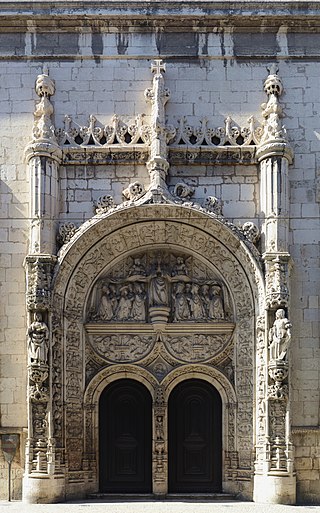
The Church of Nossa Senhora da Conceição is a church in the civil parish of Madalena, in the municipality of Lisbon.

The Prehistoric Rock-Art Site of Escoural Cave is a structure known for its Paleolithic-era rock-art and funerary burial site, located in the Portuguese municipality of Montemor-o-Novo, in the civil parish of Santiago do Escoural.
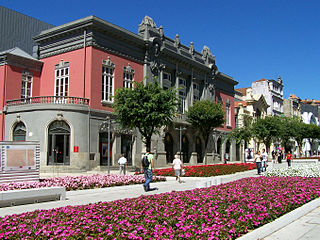
The Theatre Circo is a 20th-century, Portuguese revivalist theatre, in the civil parish of São João do Souto, municipality of Braga. Designed by the architect João de Moura Coutinho, it was first inaugurated on 21 April 1915 with a performance of Ruggero Leoncavallo's operetta La reginetta delle rose.

The Santa Apolónia Station is the oldest railway terminus in Portugal. It is situated in the civil parish of São Vicente, in the central part of the municipality of Lisbon, on the northern margin of the Tagus River in the historical district of Alfama.
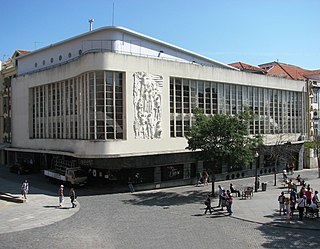
The Cinema Batalha is a Portuguese cinema and concert venue in civil parish of Cedofeita, Santo Ildefonso, Sé, Miragaia, São Nicolau e Vitória, municipality of Porto. Originally known as the Salão High-Life, it was moved from Boavista by its owners to its current location, and rebuilt by architect Artur Andrade in the Art-Deco style, re-inaugurated on 3 June 1947. After many years of success, the building and the cinema began losing customers, and was closed in 2003.
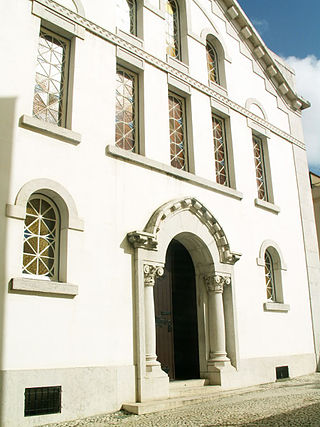
The Lisbon Synagogue is a historical synagogue situated in the civil parish of Santo António, in the municipality of Lisbon, Portugal.

The Casa dos Bicos is a historical house in the civil parish of Santa Maria Maior, in the Portuguese municipality of Lisbon. The house, built in the early 16th century in the Alfama neighbourhood, has a curious façade of spikes, influenced by Italian Renaissance palaces and Portuguese Manueline styles. It survived the disastrous 1755 Lisbon earthquake that destroyed much of the city, but over time was abandoned as a residence and used as a warehouse. After a 20th-century renovation, it became the headquarters of the José Saramago Foundation and a location of the Museum of Lisbon.

The Glória Funicular, sometimes known as the Elevador da Glória, is a funicular railway line in the civil parish of Santo António, in the municipality of Lisbon, Portugal. It connects the Pombaline downtown with the Bairro Alto, operated by Carris.

The Bica Funicular, sometimes known as the Elevador da Bica, is a funicular railway line in the civil parish of Misericórdia, in the municipality of Lisbon, Portugal. It connects the Rua de São Paulo with Calçada do Combro/Rua do Loreto, operated by Carris.

The Palace of São João Novo is a palace/residence in the civil parish of Cedofeita, Santo Ildefonso, Sé, Miragaia, São Nicolau e Vitória, in the municipality of Porto, in the Portuguese district of the same name.

The Palace of Beau-Séjour is a 19th-century Portuguese manor house situated in the civil parish of São Domingos de Benfica, municipality of Lisbon.
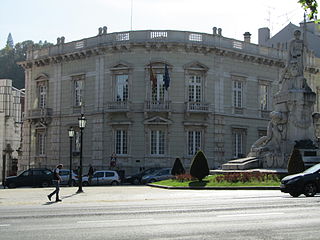
The Palacete Mayer is a Portuguese eclectical residence situated in the civil parish of Santo António, municipality of Lisbon. In the 20th century, it was acquired by the Spanish government and became the Embassy of Spain in Portugal.

The Palace of the Counts of Penafiel, commonly known as Penafiel Palace, is a Portuguese palace located in the civil parish of Santa Maria Maior, in the municipality of Lisbon. It serves as the global headquarters of the Community of Portuguese Language Countries, also known as the Lusophone Community.

The Palace of the Counts of Azambuja, alternately the Palace Valada-Azambuja is a 16th-century Portuguese estate manorhouse/palace situated in the civil parish of Misericórdia, municipality of Lisbon.
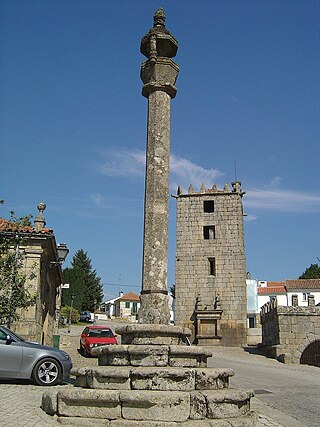
The Pillory of Aguiar da Beira is a pillory located in the civil parish of Aguiar da Beira e Coruche, in the municipality of Aguiar da Beira, Portuguese district of Guarda.

The Castle of Mirandela is a medieval castle in the civil parish of Mirandela, municipality of the same name, in the Portuguese district of Bragança.

The Castle of Aguiar da Beira, is a Portuguese medieval castle in civil parish of Aguiar da Beira e Coruche, in the municipality of Aguiar da Beira, in the Centro district of Guarda.























